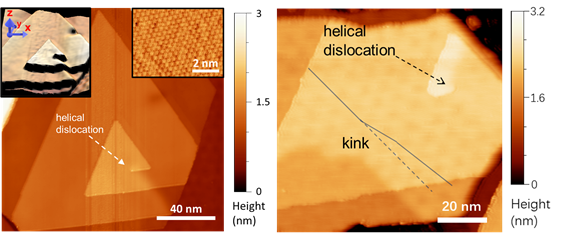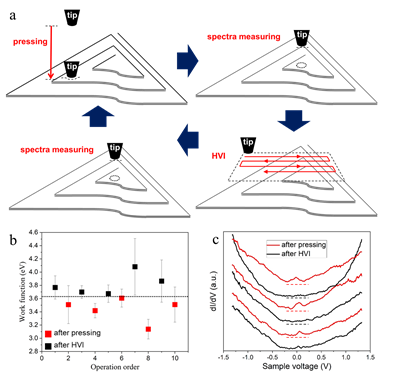Progress in Growth and Strain Effect Study of Twisted Spiral Antimonene
2023/05/10
Recently, Hongqi Xu's group from BAQIS and Peking University, in collaboration with Jian-Jun Zhang's group from the Institute of Physics of the Chinese Academy of Sciences, have reported the growth of a new layered material, spiral antimonene, using molecular beam epitaxy. They studied the strain effects of this material using in-situ scanning tunneling microscopy (STM). By controlling the residual strain in spiral antimonene using the STM tip, they observed changes in the surface electronic density of states and surface work function induced by the strain. This work, titled "Strain Effects in Twisted Spiral Antimonene", was published in Advanced Science, on April 24, 2023.
In recent years, van der Waals layered materials have attracted significant research interest. Atoms in these materials are covalently bonded in-plane, forming single layer of two-dimensional materials. Layers are then stacked together through van der Waals forces in the vertical direction. By applying interlayer twist or stress, the interlayer coupling can be controlled, leading to the emergence of rich physical properties. This has become an important research direction in the field of layered materials.
Recently, a research team led by Professor Hongqi Xu from the Beijing Academy of Quantum Information Sciences and Peking University, in collaboration with Professor Jian-Jun Zhang from Institute of Physics Chinese of the Academy of Sciences, successfully grew a new layered material, spiral antimonene, using molecular beam epitaxy. This material has a structure with lateral dimensions in hundreds of nanometers and a thickness in nanometer scale. It consists of several layers of antimonene with a helical dislocation penetrated from bottom to top. Unlike traditional layered materials, the helical dislocation spirally connects the layers of antimonene, leading to coupling between the interlayer and in-plane interactions. As a result, the material exhibits fruitful strain effects (Figure 1).
The researchers have observed anisotropic residual strain near the helical dislocations, which can impact the material's structure and physical properties. Spontaneous interlayer twist ranging from 2.3o to 3.3o were observed in spirals. By characterizing the quasi-particle interference patterns on the spirals, the anisotropy of surface electron elastic scattering was observed.
The researchers also utilized the forces generated by the STM tip to manipulate the strain in spiral antimonene (Figure 2). They achieved in-situ control of the top-layer twist angle by approximately 1o and modulated the interlayer coupling by tip interaction. They also demonstrated emerging and vanishing of electronic states near the Fermi energy under tip manipulation. They found that the variation in interlayer coupling also resulted in changes in the surface work function and demonstrated a variation of the surface work function on the order of hundreds of millielectron volts by the tip manipulation. This work provides new ideas for the study of penetrating dislocations and strain effects in layered materials for potential applications in building novel piezoelectric functional devices.
Dr. Ding-Ming Huang, a post-doctor from Beijing Academy of Quantum Information Sciences and Peking University, is the first author and a co-corresponding author of the aforementioned research. Professor Hongqi Xu and Professor Jian-Jun Zhang are co-corresponding authors. Other collaborators of this work include Professor Xu Wu and Professor Ye-Liang Wang from Beijing Institute of Technology, Researcher Kai Chang from the Beijing Academy of Quantum Information Sciences, and Professor Hao Hu from Xi'an Jiaotong University. This work was supported by grants from the National Natural Science Foundation of China.

Fig. 1. The morphology of spiral antimonene, as well as the interlayer twist and lattice distortion caused by residual strain.

Fig. 2. a) Control of residual strain using a STM tip. b) and c) The tip induced modulation on the work function and the surface electronic density of states.
Paper Information:
Strain Effects in Twisted Spiral Antimonene
Ding-Ming Huang*, Xu Wu, Kai Chang, Hao Hu, Ye-Liang Wang, H. Q. Xu*, Jian-Jun Zhang*
Advanced Science
DOI:10.1002/advs.202301326
Paper link:
https://onlinelibrary.wiley.com/doi/10.1002/advs.202301326
 中文
中文 Email
Email QCloud
QCloud Log in
Log in
